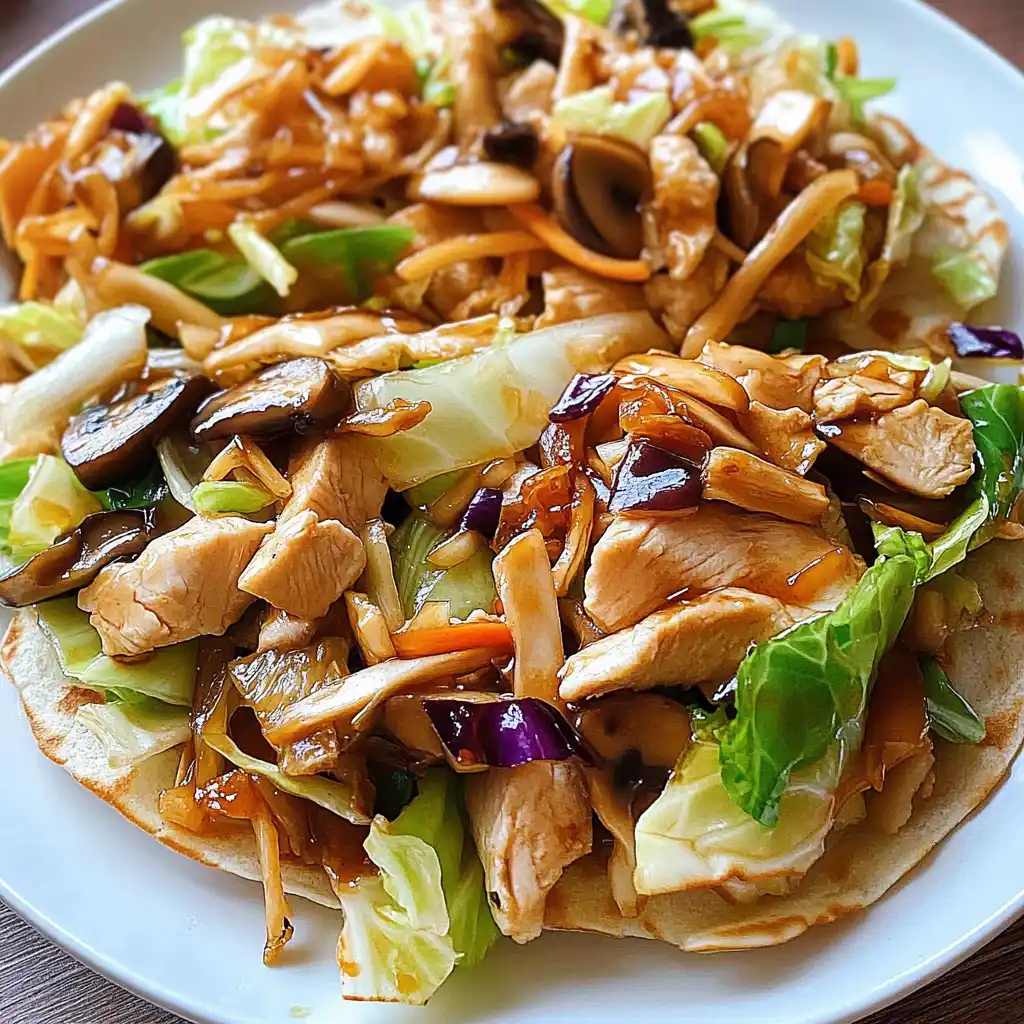If you’ve ever craved Chinese takeout with a touch of home-cooked comfort, Moo Shu Chicken might be exactly what you’re looking for. This savory, slightly sweet stir-fry blends tender chicken, crisp vegetables, fluffy scrambled eggs, and a splash of hoisin sauce—all wrapped in soft Mandarin pancakes. Sounds like a dream? It’s better than that. With roots in Northern Chinese cuisine and a strong foothold in American Chinese restaurants, Moo Shu Chicken has evolved into a dish that’s both authentic and adaptable.
In this complete guide, we’ll explore everything from its traditional ingredients to easy step-by-step recipes, regional variations, and even healthy versions that fit special diets like Paleo or Whole30. Whether you’re a beginner in the kitchen or a takeout connoisseur, you’ll discover why Moo Shu Chicken deserves a spot in your regular meal rotation. Don’t miss our guide to homemade Mandarin pancakes or the surprising differences between Moo Goo Gai Pan and Moo Shu.
Now, let’s dive into the delicious details, starting with what makes Moo Shu Chicken so unique.
Table of Contents
What Is Moo Shu Chicken? A Flavor-Packed Overview
What is Moo Shu Chicken and Where Did It Originate?
Moo Shu Chicken is a Chinese-American stir-fry dish that typically combines thinly sliced chicken breast with shredded cabbage, wood ear mushrooms, scrambled eggs, and scallions, all sautéed in a fragrant hoisin-based sauce. This mixture is traditionally served in thin Mandarin pancakes or, in some American versions, wrapped in flour tortillas.
The dish is rooted in Northern Chinese cuisine, where it originally featured pork instead of chicken and used daylily blossoms and bamboo shoots—ingredients still seen in more authentic variations. The term “moo shu” refers to the wood ear mushrooms and scrambled eggs that resemble the colors of sweet Osmanthus blossoms, giving the dish its poetic name.
Over time, Chinese immigrants adapted Moo Shu for Western palates, substituting easier-to-find ingredients and adding chicken as a popular protein alternative. It became especially popular in American Chinese restaurants during the 1960s and remains a menu staple today.
Why Moo Shu Chicken Became a Takeout Favorite in America
Moo Shu Chicken earned its place as a takeout favorite for several reasons. First, it’s fast to prepare. The ingredients are simple and easily sourced in most supermarkets. Second, its flavor profile—savory, slightly sweet, and full of umami—makes it universally appealing. The dish combines soft, crispy, and chewy textures in one bite, making every mouthful interesting and satisfying.
Perhaps the biggest factor in its popularity is the interactivity. Just like assembling a taco, diners get to fill and roll their own pancakes. This makes Moo Shu Chicken a fun and engaging meal for families, dinner parties, or even a quick weeknight dinner.
Print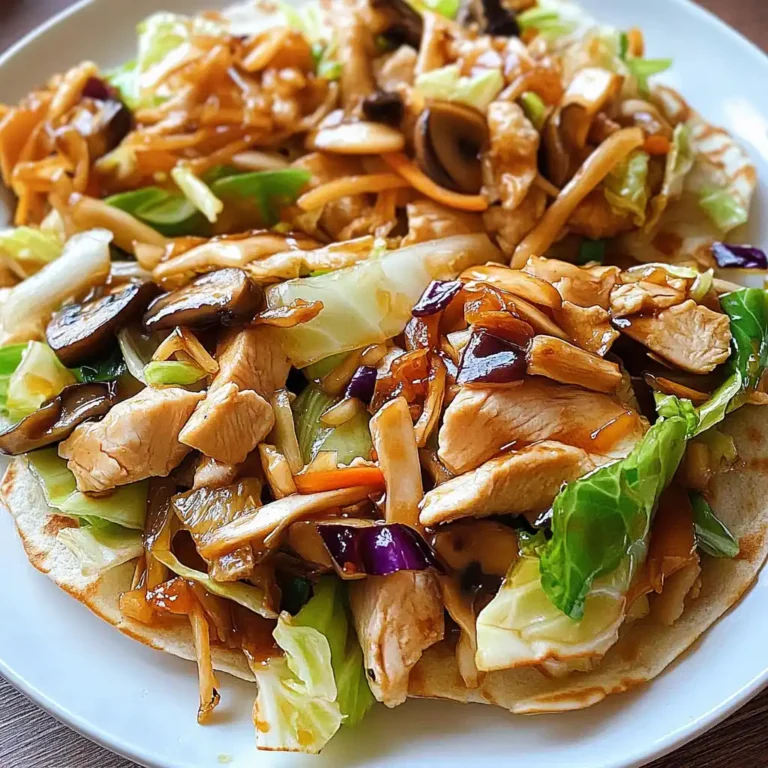
Moo Shu Chicken: The Ultimate Guide to Authentic Chinese Flavor at Home
Moo Shu Chicken is a savory, stir-fried classic that brings together tender chicken, crunchy vegetables, scrambled eggs, and hoisin sauce, all wrapped in soft Mandarin pancakes.
- Total Time: 30 minutes
- Yield: 4 servings
Ingredients
-
1 lb boneless chicken breast or thighs, thinly sliced
-
2 tbsp low-sodium soy sauce
-
1 tbsp hoisin sauce (plus more for serving)
-
1 tsp sesame oil
-
2 cups shredded Napa cabbage or green cabbage
-
½ cup carrots, julienned
-
½ cup mushrooms (shiitake or wood ear), sliced
-
3 eggs, lightly beaten
-
2 cloves garlic, minced
-
2 tbsp neutral oil (canola or peanut oil)
-
8 Mandarin pancakes or flour tortillas
-
Salt and pepper to taste
Instructions
-
In a bowl, marinate sliced chicken with soy sauce, sesame oil, and a pinch of cornstarch for 10–15 minutes.
-
Wash and slice all vegetables thinly for quick stir-frying.
-
Heat 1 tbsp oil in a wok or large skillet. Add beaten eggs and scramble until just set, then remove and set aside.
-
Add remaining oil to the pan, stir-fry marinated chicken until fully cooked (about 5–6 minutes), then remove and set aside.
-
In the same pan, stir-fry garlic, cabbage, mushrooms, and carrots for 2–3 minutes until tender-crisp.
-
Return chicken and eggs to the pan. Add hoisin sauce, toss everything together, and stir-fry for another minute.
-
Warm Mandarin pancakes or tortillas. Spoon filling into each, add extra hoisin if desired, and roll to serve.
Notes
For a low-carb version, serve in lettuce wraps. Swap chicken for tofu or shrimp for variation. Make pancakes from scratch for an authentic experience.
- Prep Time: 15 minutes
- Cook Time: 15 minutes
- Category: Main Course
- Method: Stir-Fry
- Cuisine: Chinese-American
Key Ingredients in Moo Shu Chicken
Traditional vs. Modern Moo Shu Chicken Ingredients
Moo Shu Chicken may seem simple, but the ingredients used—both traditional and modern—play a crucial role in shaping its flavor and texture.
Traditional Ingredients:
- Wood Ear Mushrooms: These give a crunchy texture and earthy flavor. Often rehydrated from dried form.
- Daylily Buds: Common in authentic Chinese recipes, they add a floral touch.
- Shredded Napa Cabbage: Light and tender, this vegetable acts as a flavorful filler.
- Eggs: Lightly scrambled and folded into the stir-fry.
- Chicken (or originally pork): Thinly sliced, marinated in soy sauce, sesame oil, and cornstarch.
Modern Adaptations:
- Green or Purple Cabbage: Easier to find and just as effective for texture.
- Carrots, Bell Peppers, or Zucchini: These add color and sweetness.
- Shiitake Mushrooms: Used as a substitute for wood ear mushrooms.
- Boneless Chicken Thighs or Breasts: Common in American kitchens and easy to cook.
- Flour Tortillas (instead of Mandarin pancakes): A practical wrap alternative.
As Moo Shu Chicken spread across the globe, cooks adapted it to fit local ingredients and preferences, making it an endlessly customizable dish.
Role of Hoisin Sauce, Mandarin Pancakes, and Vegetables
No Moo Shu Chicken is complete without its signature trio: hoisin sauce, Mandarin pancakes, and stir-fried veggies. Here’s why they matter:
Hoisin Sauce:
A thick, fragrant sauce made from soybeans, garlic, vinegar, sugar, and spices. It adds sweetness, tanginess, and depth to the dish. Often used both in the stir-fry and as a spread inside the pancake.
Mandarin Pancakes:
Soft, thin wheat flour pancakes that are warm, pliable, and perfect for rolling. They serve the same role as a tortilla but are more delicate, soaking up flavor without falling apart.
Vegetables:
Cabbage, mushrooms, scallions, and carrots provide crunch, moisture, and visual appeal. They also balance the richness of the chicken and hoisin sauce, making each bite more dynamic.
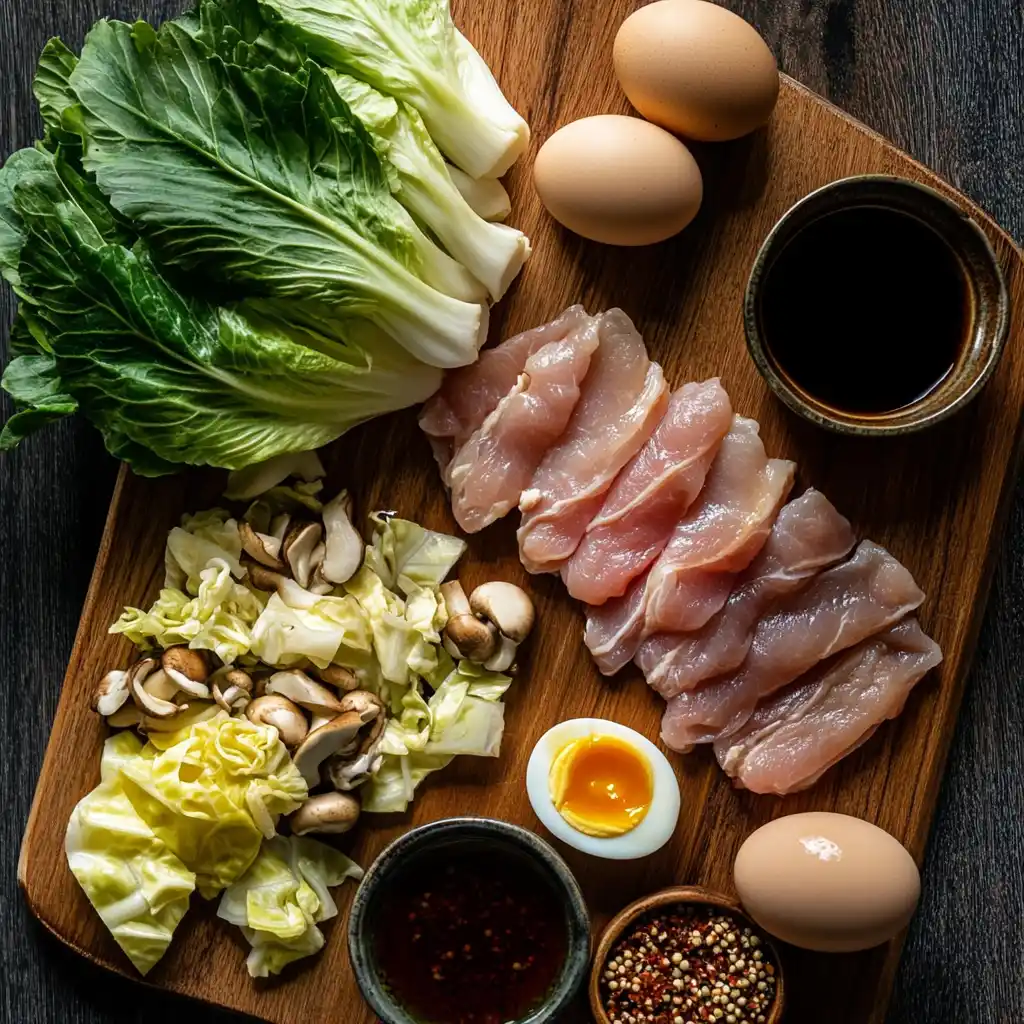
How to Cook Moo Shu Chicken at Home
Step-by-Step Recipe to Prepare Moo Shu Chicken
Cooking Moo Shu Chicken at home is simpler than it looks. Here’s a step-by-step recipe that gets you close to restaurant-quality flavor in under 30 minutes.
Ingredients (Serves 4):
- 1 lb boneless chicken breast or thighs, thinly sliced
- 2 tbsp low-sodium soy sauce
- 1 tbsp hoisin sauce (plus more for serving)
- 1 tsp sesame oil
- 2 cups shredded Napa cabbage or green cabbage
- ½ cup carrots, julienned
- ½ cup mushrooms (shiitake or wood ear), sliced
- 3 eggs, lightly beaten
- 2 cloves garlic, minced
- 2 tbsp neutral oil (like canola or peanut)
- 8 Mandarin pancakes or flour tortillas
- Salt and pepper to taste
Instructions:
- Marinate the Chicken
In a bowl, mix sliced chicken with soy sauce, sesame oil, and a pinch of cornstarch. Let it sit for 10–15 minutes while prepping the veggies. - Prepare the Vegetables
Wash and cut all veggies. Make sure everything is sliced thin for quick stir-frying. - Cook the Eggs
Heat 1 tbsp of oil in a wok or skillet over medium heat. Add the beaten eggs and scramble lightly until just set. Remove from pan and set aside. - Stir-Fry the Chicken
Add the remaining oil to the pan. Toss in the marinated chicken and stir-fry until cooked through (about 5–6 minutes). Remove and set aside. - Stir-Fry the Veggies
In the same pan, add garlic, cabbage, mushrooms, and carrots. Stir-fry for 2–3 minutes until slightly tender but still crisp. - Combine Everything
Return the eggs and chicken to the pan. Add hoisin sauce and mix well to coat everything evenly. Cook another minute to heat through. - Serve and Wrap
Warm your Mandarin pancakes or tortillas. Spoon in the filling, spread a little extra hoisin sauce, and roll them up.
Cooking Tips for Better Taste and Texture
Here’s how to elevate your Moo Shu Chicken from good to unforgettable:
- Use a hot wok: A wok’s high heat allows quick searing, locking in moisture and flavor.
- Slice thinly and evenly: Uniform cuts ensure that both meat and veggies cook evenly.
- Don’t overcook the eggs: Slightly soft scrambled eggs mix better into the dish.
- Customize your hoisin level: Add more if you prefer it sweeter; reduce for a more savory taste.
- Warm your pancakes: Cold wrappers can ruin the experience—lightly steam or pan heat them before serving.
Looking for more healthy stir-fry ideas? Don’t miss our simple chicken stir fry recipe for a quick and nutritious weeknight dinner.
Homemade Mandarin Pancakes Guide
Easy Mandarin Pancake Recipe from Scratch
While store-bought Mandarin pancakes or tortillas work in a pinch, making them from scratch elevates the Moo Shu Chicken experience. They’re soft, slightly chewy, and perfect for soaking up that savory hoisin sauce.
Ingredients (Makes about 12 pancakes):
- 2 cups all-purpose flour
- ¾ cup boiling water
- 1 tbsp sesame oil
- Extra flour for dusting
- Neutral oil for brushing
Instructions:
- Mix the Dough
In a large bowl, combine flour and boiling water. Stir with chopsticks or a wooden spoon until it forms a shaggy dough. Let it rest for 5 minutes, then knead until smooth (about 8–10 minutes). - Rest the Dough
Cover the dough with a damp towel and let it rest for 30 minutes at room temperature. This makes it easier to roll out. - Divide and Roll
Split the dough into 12 even pieces. Roll each into a ball. Pair them up, flatten two at a time, and brush one with sesame oil. Stack them (oil side in) and roll into thin circles (6–7 inches). - Cook the Pancakes
Heat a dry skillet over medium heat. Cook each double-stacked pancake for 1–2 minutes on each side until light brown spots form. Peel the layers apart while warm and stack them under a towel.
Pro Tip: The oil-layering method makes it easier to peel and yields thinner, flakier results—just like in restaurants.
How to Store and Reheat Mandarin Pancakes
Whether you’ve made a batch ahead or have leftovers, here’s how to keep your pancakes fresh:
| Storage Method | How Long | Best Practices |
|---|---|---|
| Room Temperature | 1 day | Wrap in a towel or foil |
| Refrigerator | 4–5 days | Store in a sealed container |
| Freezer | 2 months | Separate with parchment paper |
Reheating Tips:
- Microwave: Wrap in a damp paper towel and heat for 15–20 seconds.
- Steamer: Steam for 1–2 minutes until soft and warm.
- Skillet: Heat in a dry pan for 30 seconds on each side.
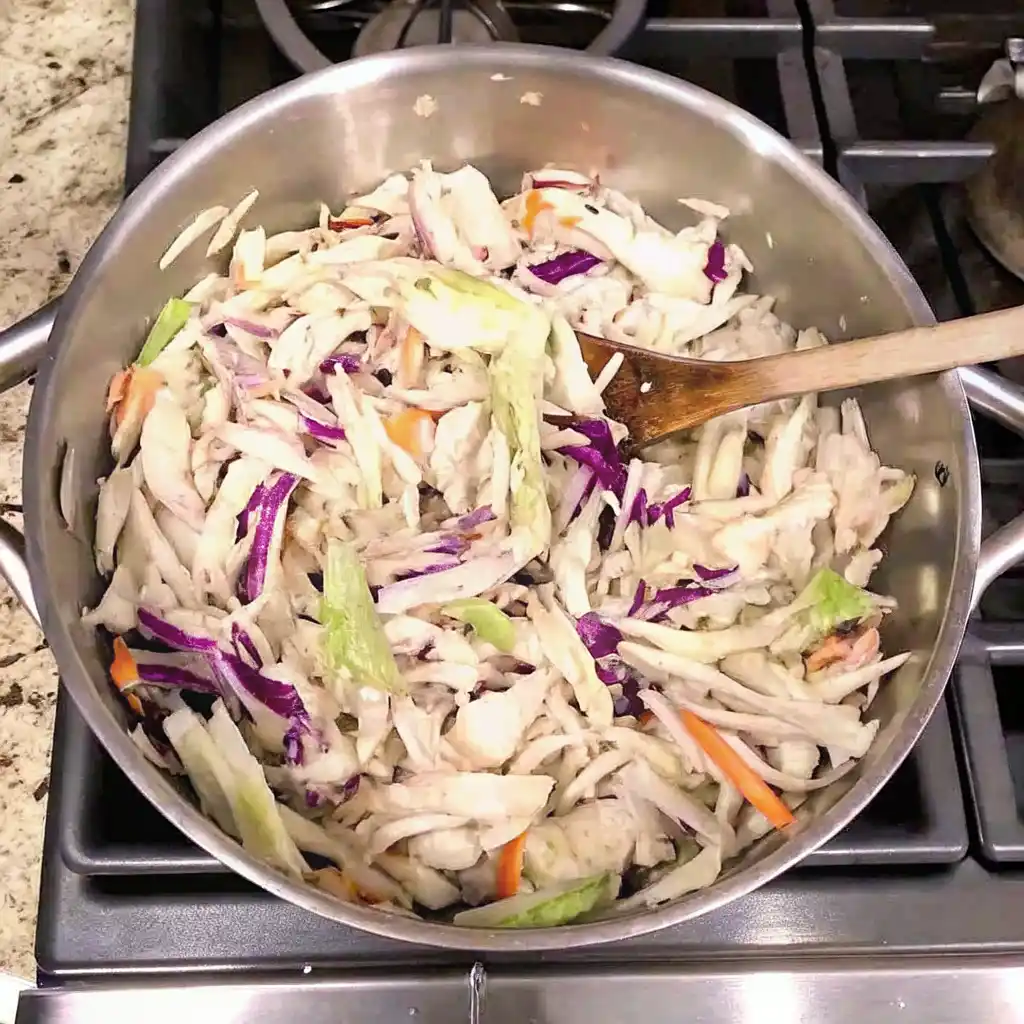
Moo Shu Chicken Variations to Try
Moo Shu Pork, Beef, Shrimp: What Changes and What Stays
One of Moo Shu’s greatest strengths is its flexibility. The classic dish may feature chicken today, but its origins actually lie in Moo Shu Pork, and the concept has since expanded to include beef, shrimp, and even duck.
Let’s break down how each protein changes the character of the dish:
| Variation | Flavor Profile | Cooking Adjustments |
|---|---|---|
| Pork | Rich and savory | Use pork shoulder or tenderloin, sliced thin |
| Beef | Deep, meaty, slightly sweet | Flank steak or sirloin works best |
| Shrimp | Light, slightly sweet | Cooks fast—add last to avoid rubberiness |
| Duck | Fatty, decadent | Often paired with plum sauce instead of hoisin |
What stays the same?
The vegetables (typically cabbage, mushrooms, and carrots), scrambled eggs, and Mandarin pancakes remain constant across all protein variations. So do the core seasonings—soy sauce, sesame oil, garlic, and hoisin sauce—though each protein may call for tweaks in marination or cooking time.
Vegetarian Moo Shu: Using Tofu or Jackfruit
Whether you’re vegan, plant-based, or just trying to reduce meat, Moo Shu adapts wonderfully to vegetarian options. Two popular substitutes:
1. Tofu Moo Shu
- Use extra-firm tofu, pressed and pan-fried until golden.
- Marinate in soy sauce, sesame oil, and hoisin before adding to the stir-fry.
- Offers a neutral flavor that absorbs seasonings beautifully.
2. Jackfruit Moo Shu
- Use young green jackfruit, shredded to mimic pulled chicken or pork.
- Best when sautéed with garlic and hoisin, then simmered until tender.
- Creates a meat-like texture with a mild fruity note.
Both versions maintain the visual appeal and texture balance of the original dish while offering a healthier, cholesterol-free alternative.
Nutritional Value and Health Benefits
Is Moo Shu Chicken Healthy?
Moo Shu Chicken can be a wholesome, nutrient-rich meal—or a calorie bomb—depending on how it’s prepared. Let’s look at the core elements that affect its health profile:
Positives:
- Lean Protein: Chicken breast or thigh offers high-quality protein, supporting muscle repair and satiety.
- Vegetable-Rich: Cabbage, mushrooms, carrots, and scallions bring fiber, antioxidants, and essential nutrients.
- Low Sugar: Traditional recipes use minimal sugar, relying on hoisin sauce for sweetness.
- Customizable: You can control sodium, oil, and portion size at home.
Considerations:
- Hoisin Sauce: While flavorful, it can be high in sugar and sodium. Look for low-sodium versions or reduce the amount used.
- Mandarin Pancakes or Tortillas: These add carbs, but choosing whole wheat options or lettuce wraps can improve the nutritional profile.
- Oil Use: Stir-frying requires oil, but you can reduce the amount or switch to avocado or olive oil for heart-health benefits.
Here’s a breakdown of the typical nutritional content for one serving (with 2 pancakes):
| Nutrient | Amount (approx.) |
|---|---|
| Calories | 350–400 kcal |
| Protein | 30–35 g |
| Fat | 12–15 g |
| Carbohydrates | 25–30 g |
| Fiber | 3–4 g |
| Sodium | 800–1000 mg |
How to Make It Paleo, Whole30, or Gluten-Free
Paleo/Whole30 Modifications:
- Skip hoisin sauce and make a compliant alternative using almond butter, coconut aminos, and garlic.
- Use coconut aminos instead of soy sauce.
- Wrap with lettuce leaves or homemade almond flour wraps.
- Choose avocado oil for cooking.
Gluten-Free Tips:
- Use tamari or coconut aminos instead of regular soy sauce.
- Check your hoisin sauce—many brands contain wheat.
- Opt for gluten-free tortillas or lettuce cups.
- Avoid store-bought pancakes unless labeled gluten-free.
These adjustments help you enjoy the deep, complex flavors of Moo Shu Chicken without compromising your dietary goals.
Want another high-protein, satisfying meal idea? Check out our egg salad sandwich recipe packed with protein and flavor.
Moo Shu Chicken vs. Moo Goo Gai Pan
Key Ingredient and Flavor Differences
While both Moo Shu Chicken and Moo Goo Gai Pan are Chinese-American favorites, they’re very different in terms of flavor, texture, and presentation. Let’s break it down:
| Feature | Moo Shu Chicken | Moo Goo Gai Pan |
|---|---|---|
| Primary Protein | Thinly sliced chicken (or pork) | Sliced chicken breast |
| Vegetables | Cabbage, mushrooms, carrots, scallions | Mushrooms, snow peas, bok choy |
| Sauce | Hoisin-based, slightly sweet & savory | Light garlic sauce, mild in flavor |
| Texture | Hearty, chewy, complex layers | Soft, delicate, and light |
| Serving Style | Wrapped in pancakes or tortillas | Served over rice or alone |
| Origin | Northern Chinese inspired | Cantonese-style |
Moo Shu is all about bold flavors and fun assembly—like building your own Chinese taco. Moo Goo Gai Pan, on the other hand, is more delicate and typically relies on subtlety rather than sauce.
Flavor Profile Comparison:
- Moo Shu Chicken bursts with umami and sweetness from hoisin sauce, contrasted by crunchy veggies and fluffy egg.
- Moo Goo Gai Pan leans toward savory and clean, with mild garlic notes and a broth-like sauce.
Which Is Better for Your Taste Preferences?
It comes down to what you’re in the mood for:
- Craving a bold, layered flavor? Go for Moo Shu Chicken. The hoisin sauce, egg, and pancake combo offers complexity and richness.
- Prefer something light and easy to digest? Moo Goo Gai Pan is your best bet. Its garlic-laced sauce and simple veggies make it comforting yet refreshing.
For special diets or low-fat meals, Moo Goo Gai Pan is often better. But for taste and fun presentation, Moo Shu wins with flair.
Serving Ideas and Side Dishes
Best Ways to Serve Moo Shu Chicken at Home
Moo Shu Chicken is not just a dish—it’s an experience. The traditional way to serve it is interactive and fun, allowing everyone at the table to build their own wrap. Here’s how to make it restaurant-worthy at home:
Classic Assembly Method:
- Warm Mandarin pancakes in a steamer or skillet.
- Spread a thin layer of hoisin sauce on the pancake.
- Spoon the chicken and veggie mixture into the center.
- Roll it up burrito-style and serve immediately.
Creative Alternatives:
- Lettuce Wraps: Use romaine or butter lettuce for a low-carb, refreshing twist.
- Rice Bowls: Serve Moo Shu Chicken over jasmine or brown rice with extra sauce.
- Stir-Fry Platter: Skip the wrap and plate the mixture with steamed greens and sesame seeds.
Perfect Side Dishes: Rice, Soup, or Noodles?
Pairing Moo Shu Chicken with the right side dish completes the meal. Here are the best companions based on flavor balance and texture:
1. Steamed Jasmine or Brown Rice
- Absorbs sauce and complements the stir-fry’s texture.
- Ideal if you’re skipping the pancakes.
2. Hot and Sour Soup
- Adds tang and spice to balance Moo Shu’s sweetness.
- Classic pairing in American Chinese cuisine.
3. Garlic Green Beans
- Crunchy and savory with a hint of spice.
- Keeps the plate green and fresh.
4. Sesame Noodles or Lo Mein
- For carb-lovers who want something heartier.
- Tossed in a light soy-sesame dressing, they round out the meal beautifully.
5. Pickled Vegetables
- Quick-pickled cucumbers or radish slices offer acidity that cuts through the richness.
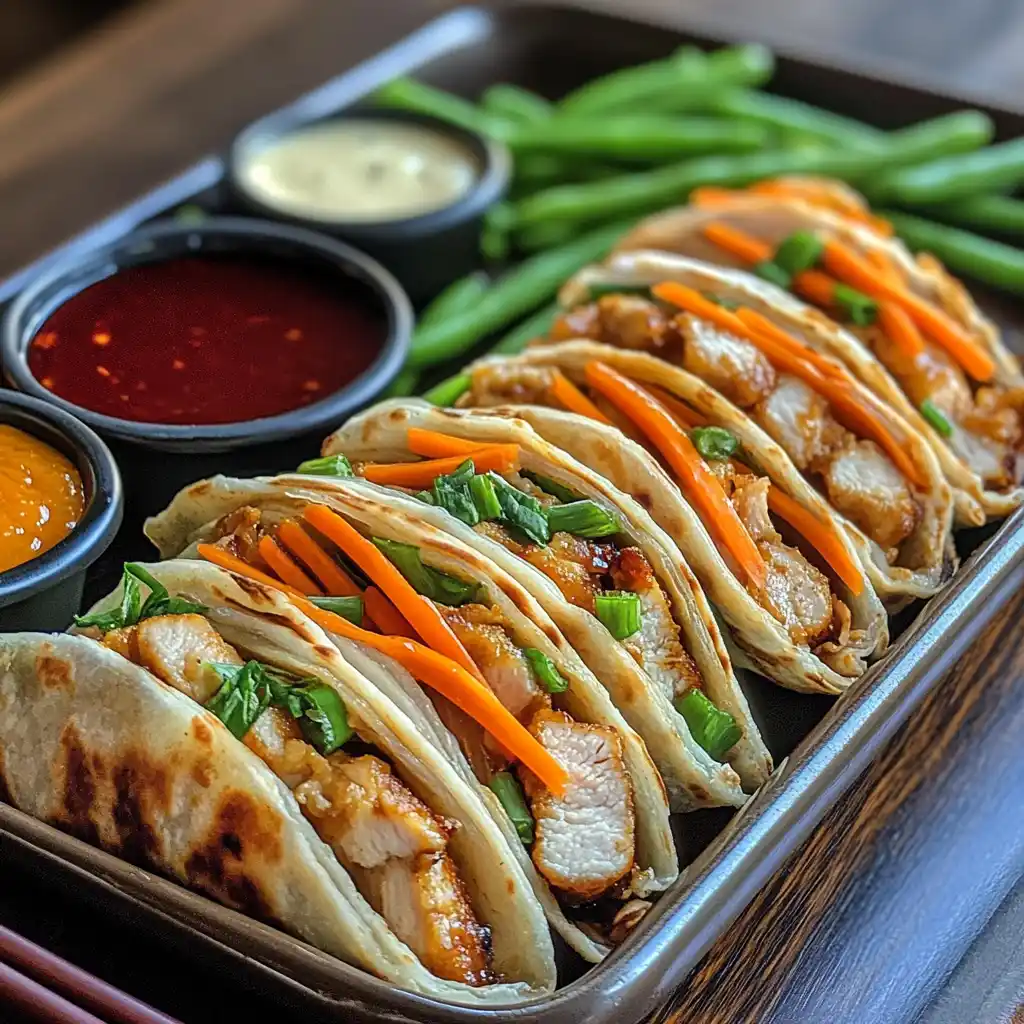
Common Questions About Moo Shu Chicken (FAQs)
What is a Moo Shu Chicken?
Moo Shu Chicken is a Chinese-American stir-fry dish that typically includes thinly sliced chicken breast, scrambled eggs, mushrooms, cabbage, and carrots, all sautéed in a savory-sweet hoisin sauce. It’s served with warm Mandarin pancakes (or tortillas) that diners use to wrap the mixture taco-style. The dish is inspired by a traditional Northern Chinese pork recipe but has evolved into a chicken-based favorite in the West.
What is Moo Shu made of?
The core ingredients of Moo Shu vary slightly, but traditional and modern versions include:
- Sliced protein (chicken, pork, shrimp, or tofu)
- Scrambled eggs
- Shredded cabbage and carrots
- Mushrooms (usually wood ear or shiitake)
- Scallions or green onions
- Hoisin sauce for bold flavor
- Mandarin pancakes or tortillas as the wrap
This combination gives Moo Shu its signature mix of textures and umami flavor.
What is the difference between Moo Goo and Moo Shu?
Moo Goo (specifically Moo Goo Gai Pan) and Moo Shu may sound similar, but they’re quite different:
| Dish | Moo Shu Chicken | Moo Goo Gai Pan |
|---|---|---|
| Protein | Chicken or pork | Chicken only |
| Sauce | Hoisin-based, sweet-savory | Light garlic sauce, more neutral |
| Vegetables | Cabbage, mushrooms, carrots, scallions | Mushrooms, snow peas, bok choy |
| Presentation | Served with pancakes or tortillas | Served over rice or on its own |
| Taste | Bold, slightly sweet, and rich | Mild, delicate, and light |
In short: Moo Shu is punchier and interactive; Moo Goo is subtler and more traditional.
What does Mushu mean in Chinese food?
In Chinese cuisine, “Moo Shu” (sometimes spelled “Mu Shu” or “Mushu”) refers to the inclusion of scrambled egg and wood ear mushrooms, which resemble the yellow blossoms of the Osmanthus tree. The name “moo shu” originates from the Mandarin word for “Osmanthus,” symbolizing the visual color combination in the original pork-based version of the dish. It’s more about appearance than a literal ingredient, though eggs and mushrooms remain key components.
Conclusion: Why Moo Shu Chicken Deserves a Spot in Your Recipe Repertoire
Moo Shu Chicken isn’t just a meal—it’s a full culinary experience. From the savory umami-packed chicken and egg stir-fry to the soft, chewy Mandarin pancakes, every element plays a role in building bold flavor and fun presentation. Whether you’re making it with classic wood ear mushrooms or a modern twist with lettuce wraps and gluten-free options, this dish adapts easily to your taste and lifestyle.
Not only is it healthier than takeout when made at home, but it’s also easy to prepare, deeply satisfying, and perfect for weeknight dinners or special occasions. Plus, with customizable proteins and wraps, there’s a Moo Shu for everyone—from meat-lovers to vegetarians to low-carb eaters.

